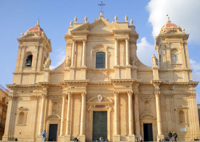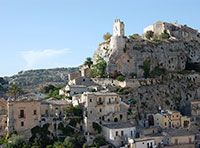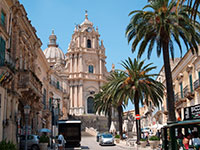Excursion to Noto, Modica, Ragusa
Our program
It is a tour to the south east of Sicily, along the Ionian Sea, we discover the historical and cultural roots and even the culinary Sicilian Baroque style built after the devasting earthquake of 1693.
Noto
 We will start from Noto Sicily, the main street of Noto, Corso Vittorio Emanuele and is divided into three squares. In each square a church.
We will start from Noto Sicily, the main street of Noto, Corso Vittorio Emanuele and is divided into three squares. In each square a church.
The Porta Reale is a monumental entrance to the city in the form of a triumphal arch, built in the nineteenth century. The door is surmounted by a pelican, symbol of self-denial and on both sides there is a tower, symbol of strength and a Cirneco (ancient breed), symbol of fidelity.
We see then the Piazza Municipio (town hall), it is the most majestic and lively of the three squares, bounded on the left by the façade of Palazzo Ducetius and on the right the winding stairs that bring you to the entrance of the cathedral where two horse shoe shaped hedges.
Noto Cathedral, wide frontage with two tall bell towers, with a glimpse you see in the background the remains of the dome that unfortunately collapsed destroying a great section of the nave in 1966.
Its only being a while of the re-opening of the Cathedral returning to the city and the world all its beauty of the Baroque style. Along the side stands Palazzo Vescovile ( bishops palace) and Palazzo Landolina of Sant’ Alfano, both sober lines and seem to counterbalance the exuberance of the other buildings in the square.
Via Nicolaci brings you to the Church of Montevergine, with its beautiful concave framed between two towers, the work of Sinatra. The two sides of the street are lined with beautiful baroque buildings, Palazzo Nicolaci of Villadorata with exuberant balconies. The palace is Noto largest house with 100 rooms and owned by the Prince of Nicolaci.
The church of San Domenico a stiking design highlighted by superimposed columns and separated by a high cornice. The interior is white with marble alters.
In front of the church lies the Villetta D’ Ercole, with a eighteenth century fountain surrounded by a beautiful garden. Opposite stands the nineteenth century Teatro Vittorio Emanuele III.
Following to Via Cavour a noble street, in which has beautiful balconies and and baroque style façades. Main palaces are Palazzo Astuto and Palazzo Trigona Cannicarao.
Modica
 Sicily Tour "Sicilian Baroque Tour" continue to Modica, its ancient town depicted in many ways. It has a famous bridge tallest of Europe overlooking the city. It is a Baroque town and suffered earthquakes of 1613 and 1693 and also major floods.
Sicily Tour "Sicilian Baroque Tour" continue to Modica, its ancient town depicted in many ways. It has a famous bridge tallest of Europe overlooking the city. It is a Baroque town and suffered earthquakes of 1613 and 1693 and also major floods.
Modica was rebuilt after these disasters and was the birth place of the famous Nobel Prize for Literature Salvatore Quasimodo and Tommaso Campailla an 18th century scientist and philosopher.
We visit the Duomo di San Giorgio and the Church of San Pietro. We continue with a visit to the ancient Dolceria Bonajuto to taste the famous Chocolate in Modica. Still today they carry the traditional recipes of the Aztecs.
Ragusa
 The last step of Sicilian Baroque Tour is Ragusa. the town lies on the southern part of the mountains Hyblaean.
The last step of Sicilian Baroque Tour is Ragusa. the town lies on the southern part of the mountains Hyblaean.
The post earthquake reconstruction divided the two major area Ragusa and Ragusa Ibla, built on the ruins of the ancient city and rebuilt according to the ancient medieval structure.
We visit the Duomo di San Giorgo and the Garden Ibleo. We finish off to a farm to taste the famous cheese Ragusano and their typical produce.
A the end of Sicily Tour "Sicilian Baroque Tour" we will go back to the hotel admiring the views.